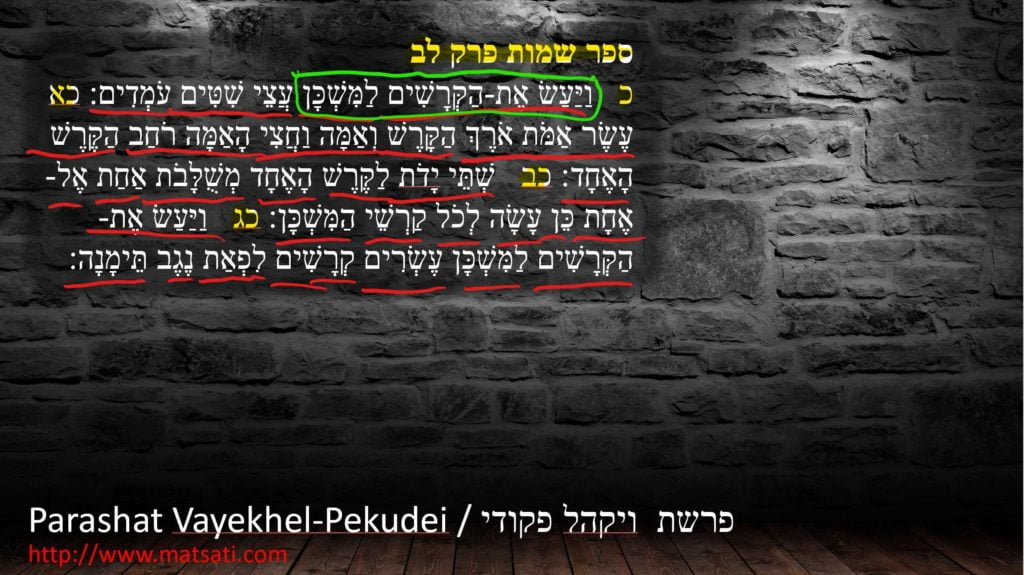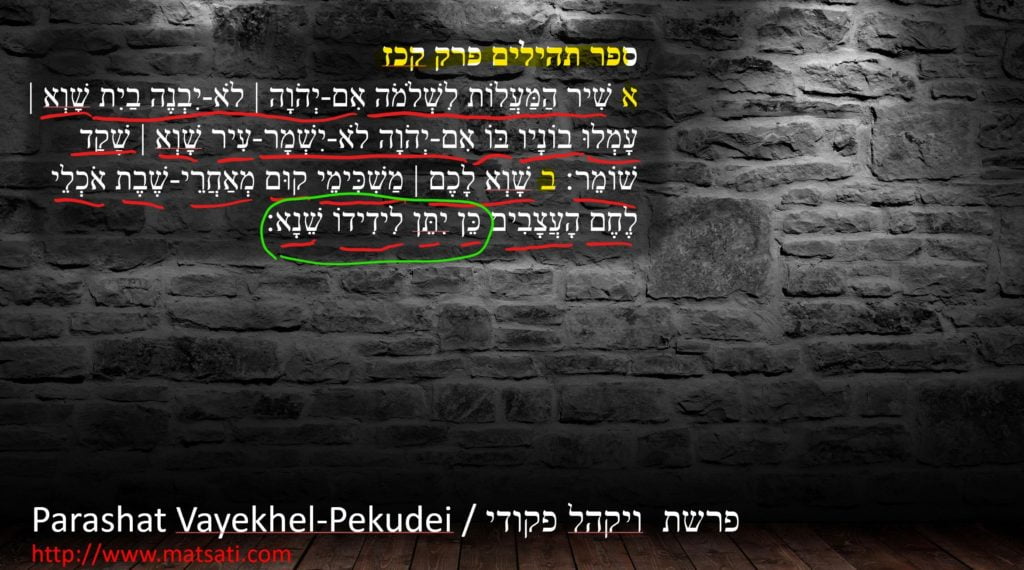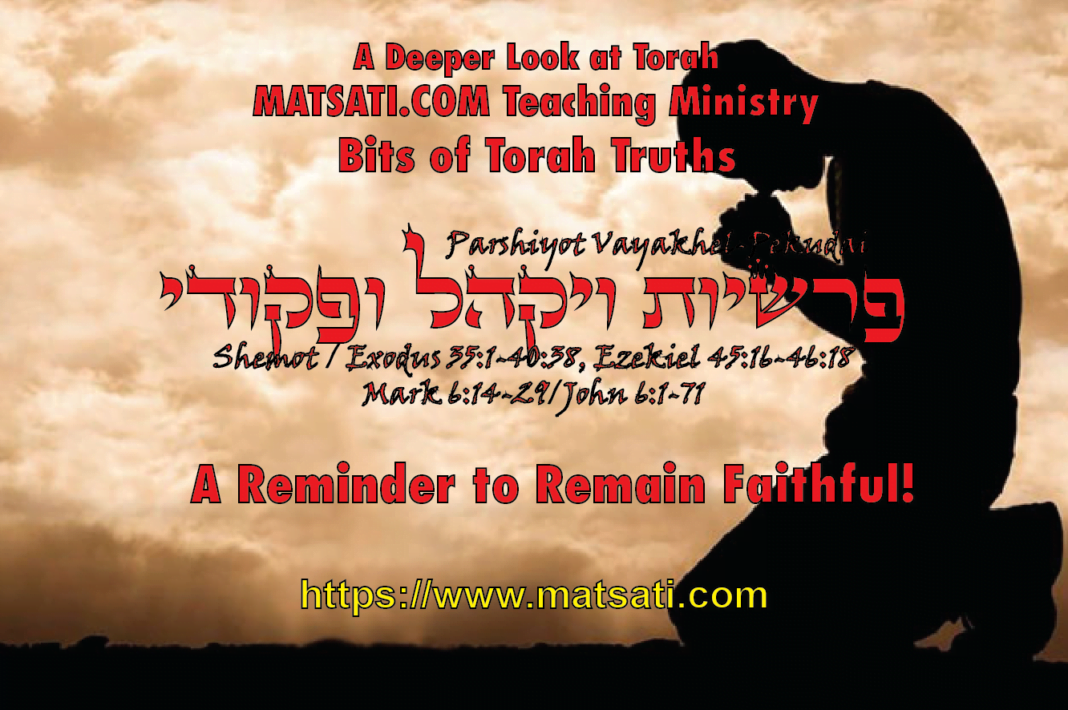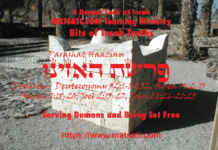This week is a double Torah portion, Parshiyot Vayakhel and Pekudei. The final chapters of the book of Shemot / Exodus contains the following: regulations on the Shabbat (Shemot / Exodus 35:1-3), materials brought for the Tabernacle (Shemot / Exodus 35:4-29), Bezalel and Oholiab chosen as skilled men to make the things for the Tabernacle and its construction (Shemot / Exodus.35.30-36.7), listing the individual parts of the Tabernacle (how it was made, Shemot / Exodus 36:8-38), the making of the Ark of the Covenant (Shemot / Exodus 37:1-9), the table of the presence (Shemot / Exodus 37:10-16), the golden lamp stand (Shemot / Exodus 37:17-24), the Altar of incense (Shemot / Exodus 37:25-29), the Altar for burnt offerings (Shemot / Exodus 38:1-7), the basin for washing (Shemot / Exodus 38:8), The courtyard of the tabernacle (Shemot / Exodus 38:9-20), the materials used for the Tabernacle (Shemot / Exodus 38:21-31), The priestly garments (Shemot / Exodus 39:1), the Ephod (Shemot / Exodus 39:2-7), the breast piece (Shemot / Exodus 39:8-21), other things related to the priestly garments (Shemot / Exodus 39:22-31), Moshe inspects the parts (Shemot / Exodus 39:32-43), and then the actual setting up of the Tabernacle (Shemot / Exodus 40:1-33) and lastly, the glory of the Lord appears in a cloud on the Tabernacle (Shemot / Exodus 40:34-38). Now reading through these passages may seem a bit tedious. Someone might even think these passages of Scripture are relatively unimportant besides that it keeps a particular record for how these things were constructed and put into place within the Tabernacle. While reading through these Scriptures, the Lord laid a very important point upon my heart that I would like to discuss that is related and paralleled to this week’s double portion.

The specific verses that spoke to me from the portion of Scriptures was specifically from, Shemot / Exodus 36:20-30, כ וַיַּעַשֹ אֶת-הַקְּרָשִׁים לַמִּשְׁכָּן עֲצֵי שִׁטִּים עֹמְדִים: כא עֶשֶֹר אַמֹּת אֹרֶךְ הַקָּרֶשׁ וְאַמָּה וַחֲצִי הָאַמָּה רֹחַב הַקֶּרֶשׁ הָאֶחָד: כב שְׁתֵּי יָדֹת לַקֶּרֶשׁ הָאֶחָד מְשֻׁלָּבֹת אַחַת אֶל-אֶחָת כֵּן עָשָֹה לְכֹל קַרְשֵׁי הַמִּשְׁכָּן: כג וַיַּעַשֹ אֶת-הַקְּרָשִׁים לַמִּשְׁכָּן עֶשְֹרִים קְרָשִׁים לִפְאַת נֶגֶב תֵּימָנָה: כד וְאַרְבָּעִים אַדְנֵי-כֶסֶף עָשָֹה תַּחַת עֶשְֹרִים הַקְּרָשִׁים שְׁנֵי אֲדָנִים תַּחַת-הַקֶּרֶשׁ הָאֶחָד לִשְׁתֵּי יְדֹתָיו וּשְׁנֵי אֲדָנִים תַּחַת-הַקֶּרֶשׁ הָאֶחָד לִשְׁתֵּי יְדֹתָיו: כה וּלְצֶלַע הַמִּשְׁכָּן הַשֵּׁנִית לִפְאַת צָפוֹן עָשָֹה עֶשְֹרִים קְרָשִׁים: כו וְאַרְבָּעִים אַדְנֵיהֶם כָּסֶף שְׁנֵי אֲדָנִים תַּחַת הַקֶּרֶשׁ הָאֶחָד וּשְׁנֵי אֲדָנִים תַּחַת הַקֶּרֶשׁ הָאֶחָד: כז וּלְיַרְכְּתֵי הַמִּשְׁכָּן יָמָּה עָשָֹה שִׁשָּׁה קְרָשִׁים: כח וּשְׁנֵי קְרָשִׁים עָשָֹה לִמְקֻצְעֹת הַמִּשְׁכָּן בַּיַּרְכָתָיִם: כט וְהָיוּ תוֹאֲמִם מִלְּמַטָּה וְיַחְדָּו יִהְיוּ תַמִּים אֶל-רֹאשׁוֹ אֶל-הַטַּבַּעַת הָאֶחָת כֵּן עָשָֹה לִשְׁנֵיהֶם לִשְׁנֵי הַמִּקְצֹעֹת: ל וְהָיוּ שְׁמֹנָה קְרָשִׁים וְאַדְנֵיהֶם כֶּסֶף שִׁשָּׁה עָשָֹר אֲדָנִים שְׁנֵי אֲדָנִים שְׁנֵי אֲדָנִים תַּחַת הַקֶּרֶשׁ הָאֶחָד: 36:20 They made upright frames of acacia wood for the tabernacle. 36:21 Each frame was ten cubits long and a cubit and a half wide, 36:22 with two projections set parallel to each other. They made all the frames of the tabernacle in this way. 36:23 They made twenty frames for the south side of the tabernacle 36:24 and made forty silver bases to go under them—two bases for each frame, one under each projection. 36:25 For the other side, the north side of the tabernacle, they made twenty frames 36:26 and forty silver bases—two under each frame. 36:27 They made six frames for the far end, that is, the west end of the tabernacle, 36:28 and two frames were made for the corners of the tabernacle at the far end. 36:29 At these two corners the frames were double from the bottom all the way to the top and fitted into a single ring; both were made alike. 36:30 So there were eight frames and sixteen silver bases—two under each frame. (NASB) We note what the text states, וַיַּעַשֹ אֶת-הַקְּרָשִׁים לַמִּשְׁכָּן עֲצֵי שִׁטִּים עֹמְדִים that they fashioned הַקְּרָשִׁים (boards) of acacia wood which functioned as frames for the tabernacle. Here the NASB translates הַקְּרָשִׁים as “frames” which reminded me of stick frame construction of a house. “Stick framing” is a term, that comes from how builders assemble the exterior and interior walls of a house “stick by stick.” When we think about stick frame construction, generally what comes to mind is solid construction. Traditional stick framing is what most of us envision when we think about building a new home. Dimensional lumber (measured/precut lumber) is readily available at lumber yards in nearly every town and village across America. Note how here carpenters had to individually construct each beam and pole for the frame construction of the Tabernacle. Today however, with traditional stick framing, lumber is brought to a building site upon where a house structure is framed. Stick framing, as a term, comes from framers assembling a house shell “stick by stick.” With stick framing, typically 2×4 or 2×6 pieces of lumber are placed 16 or 24 inches apart to construct a framework for walls, floors, ceilings and roof rafters. Stick frame construction is very solid construction! The reason I am so strongly reminded of this is back a number of years ago I owned a home that was not traditionally stick framed. The two story house was a modular home where the various rooms and floors were prefabricated and then brought to the construction site and a crane was used to lift the pieces into place and the builder simply secured each piece to one another and then the house framing work was completed in just one day saving a lot of time. The builder then simply had to focus upon the insulation, electric and plumbing, dry walling, roof, and siding, etc. Now the reason this construction method is not as solid, is due to what I had been told by my neighbors. All of the homes had been constructed using this modular approach. On a couple of the homes, the builder did not do so good a job of securing the different modular pieces together. What happened was as the foundation and house settled over the course of a few years, the modules separated and produced large cracks in the dry wall which revealed the shoddy construction. Obviously in this case, stick frame construction was a better method of construction as this problem would not have happened! The idea that the Tabernacle was constructed frame-by-frame (36:20-24) parallels stick frame construction and speaks to its enduring qualities. These things have a significant application for our lives today as we are God’s dwelling place, our hearts and lives are the dwelling place of God. Therefore we are not to take a modular approach to our faith and our relationship with God. Let’s discuss these things a little further!
The verses we are looking at for this week are from Shemot / Exodus 36:8-34.
ספר שמות פרק לו
ח וַיַּעֲשֹוּ כָל-חֲכַם-לֵב בְּעֹשֵֹי הַמְּלָאכָה אֶת-הַמִּשְׁכָּן עֶשֶֹר יְרִיעֹת שֵׁשׁ מָשְׁזָר וּתְכֵלֶת וְאַרְגָּמָן וְתוֹלַעַת שָׁנִי כְּרֻבִים מַעֲשֵֹה חֹשֵׁב עָשָֹה אֹתָם: ט אֹרֶךְ הַיְרִיעָה הָאַחַת שְׁמֹנֶה וְעֶשְֹרִים בָּאַמָּה וְרֹחַב אַרְבַּע בָּאַמָּה הַיְרִיעָה הָאֶחָת מִדָּה אַחַת לְכָל-הַיְרִיעֹת: י וַיְחַבֵּר אֶת-חֲמֵשׁ הַיְרִיעֹת אַחַת אֶל-אֶחָת וְחָמֵשׁ יְרִיעֹת חִבַּר אַחַת אֶל-אֶחָת: יא וַיַּעַשֹ לֻלְאֹת תְּכֵלֶת עַל שְֹפַת הַיְרִיעָה הָאֶחָת מִקָּצָה בַּמַּחְבָּרֶת כֵּן עָשָֹה בִּשְֹפַת הַיְרִיעָה הַקִּיצוֹנָה בַּמַּחְבֶּרֶת הַשֵּׁנִית: יב חֲמִשִּׁים לֻלָאֹת עָשָֹה בַּיְרִיעָה הָאֶחָת וַחֲמִשִּׁים לֻלָאֹת עָשָֹה בִּקְצֵה הַיְרִיעָה אֲשֶׁר בַּמַּחְבֶּרֶת הַשֵּׁנִית מַקְבִּילֹת הַלֻּלָאֹת אַחַת אֶל-אֶחָת: יג וַיַּעַשֹ חֲמִשִּׁים קַרְסֵי זָהָב וַיְחַבֵּר אֶת-הַיְרִיעֹת אַחַת אֶל-אַחַת בַּקְּרָסִים וַיְהִי הַמִּשְׁכָּן אֶחָד: פ יד וַיַּעַשֹ יְרִיעֹת עִזִּים לְאֹהֶל עַל-הַמִּשְׁכָּן עַשְׁתֵּי-עֶשְֹרֵה יְרִיעֹת עָשָֹה אֹתָם: טו אֹרֶךְ הַיְרִיעָה הָאַחַת שְׁלֹשִׁים בָּאַמָּה וְאַרְבַּע אַמּוֹת רֹחַב הַיְרִיעָה הָאֶחָת מִדָּה אַחַת לְעַשְׁתֵּי עֶשְֹרֵה יְרִיעֹת: טז וַיְחַבֵּר אֶת-חֲמֵשׁ הַיְרִיעֹת לְבָד וְאֶת-שֵׁשׁ הַיְרִיעֹת לְבָד: יז וַיַּעַשֹ לֻלָאֹת חֲמִשִּׁים עַל שְֹפַת הַיְרִיעָה הַקִּיצֹנָה בַּמַּחְבָּרֶת וַחֲמִשִּׁים לֻלָאֹת עָשָֹה עַל-שְֹפַת הַיְרִיעָה הַחֹבֶרֶת הַשֵּׁנִית: יח וַיַּעַשֹ קַרְסֵי נְחֹשֶׁת חֲמִשִּׁים לְחַבֵּר אֶת-הָאֹהֶל לִהְיֹת אֶחָד: יט וַיַּעַשֹ מִכְסֶה לָאֹהֶל עֹרֹת אֵילִם מְאָדָּמִים וּמִכְסֵה עֹרֹת תְּחָשִׁים מִלְמָעְלָה: ס [חמישי] כ וַיַּעַשֹ אֶת-הַקְּרָשִׁים לַמִּשְׁכָּן עֲצֵי שִׁטִּים עֹמְדִים: כא עֶשֶֹר אַמֹּת אֹרֶךְ הַקָּרֶשׁ וְאַמָּה וַחֲצִי הָאַמָּה רֹחַב הַקֶּרֶשׁ הָאֶחָד: כב שְׁתֵּי יָדֹת לַקֶּרֶשׁ הָאֶחָד מְשֻׁלָּבֹת אַחַת אֶל-אֶחָת כֵּן עָשָֹה לְכֹל קַרְשֵׁי הַמִּשְׁכָּן: כג וַיַּעַשֹ אֶת-הַקְּרָשִׁים לַמִּשְׁכָּן עֶשְֹרִים קְרָשִׁים לִפְאַת נֶגֶב תֵּימָנָה: כד וְאַרְבָּעִים אַדְנֵי-כֶסֶף עָשָֹה תַּחַת עֶשְֹרִים הַקְּרָשִׁים שְׁנֵי אֲדָנִים תַּחַת-הַקֶּרֶשׁ הָאֶחָד לִשְׁתֵּי יְדֹתָיו וּשְׁנֵי אֲדָנִים תַּחַת-הַקֶּרֶשׁ הָאֶחָד לִשְׁתֵּי יְדֹתָיו: כה וּלְצֶלַע הַמִּשְׁכָּן הַשֵּׁנִית לִפְאַת צָפוֹן עָשָֹה עֶשְֹרִים קְרָשִׁים: כו וְאַרְבָּעִים אַדְנֵיהֶם כָּסֶף שְׁנֵי אֲדָנִים תַּחַת הַקֶּרֶשׁ הָאֶחָד וּשְׁנֵי אֲדָנִים תַּחַת הַקֶּרֶשׁ הָאֶחָד: כז וּלְיַרְכְּתֵי הַמִּשְׁכָּן יָמָּה עָשָֹה שִׁשָּׁה קְרָשִׁים: כח וּשְׁנֵי קְרָשִׁים עָשָֹה לִמְקֻצְעֹת הַמִּשְׁכָּן בַּיַּרְכָתָיִם: כט וְהָיוּ תוֹאֲמִם מִלְּמַטָּה וְיַחְדָּו יִהְיוּ תַמִּים אֶל-רֹאשׁוֹ אֶל-הַטַּבַּעַת הָאֶחָת כֵּן עָשָֹה לִשְׁנֵיהֶם לִשְׁנֵי הַמִּקְצֹעֹת: ל וְהָיוּ שְׁמֹנָה קְרָשִׁים וְאַדְנֵיהֶם כֶּסֶף שִׁשָּׁה עָשָֹר אֲדָנִים שְׁנֵי אֲדָנִים שְׁנֵי אֲדָנִים תַּחַת הַקֶּרֶשׁ הָאֶחָד: לא וַיַּעַשֹ בְּרִיחֵי עֲצֵי שִׁטִּים חֲמִשָּׁה לְקַרְשֵׁי צֶלַע-הַמִּשְׁכָּן הָאֶחָת: לב וַחֲמִשָּׁה בְרִיחִם לְקַרְשֵׁי צֶלַע-הַמִּשְׁכָּן הַשֵּׁנִית וַחֲמִשָּׁה בְרִיחִם לְקַרְשֵׁי הַמִּשְׁכָּן לַיַּרְכָתַיִם יָמָּה: לג וַיַּעַשֹ אֶת-הַבְּרִיחַ הַתִּיכֹן לִבְרֹחַ בְּתוֹךְ הַקְּרָשִׁים מִן-הַקָּצֶה אֶל-הַקָּצֶה: לד וְאֶת-הַקְּרָשִׁים צִפָּה זָהָב וְאֶת-טַבְּעֹתָם עָשָֹה זָהָב בָּתִּים לַבְּרִיחִם וַיְצַף אֶת-הַבְּרִיחִם זָהָב:
Shemot / Exodus 36:8-34
36:8 All the skillful men among those who were performing the work made the tabernacle with ten curtains; of fine twisted linen and blue and purple and scarlet material, with cherubim, the work of a skillful workman, Bezalel made them. 36:9 The length of each curtain was twenty-eight cubits and the width of each curtain four cubits; all the curtains had the same measurements. 36:10 He joined five curtains to one another and the other five curtains he joined to one another. 36:11 He made loops of blue on the edge of the outermost curtain in the first set; he did likewise on the edge of the curtain that was outermost in the second set. 36:12 He made fifty loops in the one curtain and he made fifty loops on the edge of the curtain that was in the second set; the loops were opposite each other. 36:13 He made fifty clasps of gold and joined the curtains to one another with the clasps, so the tabernacle was a unit. 36:14 Then he made curtains of goats’ hair for a tent over the tabernacle; he made eleven curtains in all. 36:15 The length of each curtain was thirty cubits and four cubits the width of each curtain; the eleven curtains had the same measurements. 36:16 he joined five curtains by themselves and the other six curtains by themselves. 36:17 Moreover, he made fifty loops on the edge of the curtain that was outermost in the first set, and he made fifty loops on the edge of the curtain that was outermost in the second set. 36:18 He made fifty clasps of bronze to join the tent together so that it would be a unit. 36:19 He made a covering for the tent of rams’ skins dyed red, and a covering of porpoise skins above. 36:20 Then he made the boards for the tabernacle of acacia wood, standing upright. 36:21 Ten cubits was the length of each board and one and a half cubits the width of each board. 36:22 There were two tenons for each board, fitted to one another; thus he did for all the boards of the tabernacle. 36:23 He made the boards for the tabernacle: twenty boards for the south side; 36:24 and he made forty sockets of silver under the twenty boards; two sockets under one board for its two tenons and two sockets under another board for its two tenons. 36:25 Then for the second side of the tabernacle, on the north side, he made twenty boards, 36:26 and their forty sockets of silver; two sockets under one board and two sockets under another board. 36:27 For the rear of the tabernacle, to the west, he made six boards. 36:28 He made two boards for the corners of the tabernacle at the rear. 36:29 They were double beneath, and together they were complete to its top to the first ring; thus he did with both of them for the two corners. 36:30 There were eight boards with their sockets of silver, sixteen sockets, two under every board. 36:31 Then he made bars of acacia wood, five for the boards of one side of the tabernacle, 36:32 and five bars for the boards of the other side of the tabernacle, and five bars for the boards of the tabernacle for the rear side to the west. 36:33 He made the middle bar to pass through in the center of the boards from end to end. 36:34 He overlaid the boards with gold and made their rings of gold as holders for the bars, and overlaid the bars with gold. (NASB)
As we read the Torah portion for this week, we read Shemot / Exodus 36:20-24, כ וַיַּעַשֹ אֶת-הַקְּרָשִׁים לַמִּשְׁכָּן עֲצֵי שִׁטִּים עֹמְדִים: כא עֶשֶֹר אַמֹּת אֹרֶךְ הַקָּרֶשׁ וְאַמָּה וַחֲצִי הָאַמָּה רֹחַב הַקֶּרֶשׁ הָאֶחָד: כב שְׁתֵּי יָדֹת לַקֶּרֶשׁ הָאֶחָד מְשֻׁלָּבֹת אַחַת אֶל-אֶחָת כֵּן עָשָֹה לְכֹל קַרְשֵׁי הַמִּשְׁכָּן: כג וַיַּעַשֹ אֶת-הַקְּרָשִׁים לַמִּשְׁכָּן עֶשְֹרִים קְרָשִׁים לִפְאַת נֶגֶב תֵּימָנָה: כד וְאַרְבָּעִים אַדְנֵי-כֶסֶף עָשָֹה תַּחַת עֶשְֹרִים הַקְּרָשִׁים שְׁנֵי אֲדָנִים תַּחַת-הַקֶּרֶשׁ הָאֶחָד לִשְׁתֵּי יְדֹתָיו וּשְׁנֵי אֲדָנִים תַּחַת-הַקֶּרֶשׁ הָאֶחָד לִשְׁתֵּי יְדֹתָיו: 36:20 They made upright frames of acacia wood for the tabernacle. 36:21 Each frame was ten cubits long and a cubit and a half wide, 36:22 with two projections set parallel to each other. They made all the frames of the tabernacle in this way. 36:23 They made twenty frames for the south side of the tabernacle 36:24 and made forty silver bases to go under them—two bases for each frame, one under each projection. (NASB) This speaks to construction with a specific design and purpose. This applies to our lives as we learned last week how God has a plan and purpose for our lives too. Now in the modern scientific community, most psychologists believe that the human body consists simply of the sum of their parts. All of the feelings and convictions to sin are simply chemical responses in the brain. Those of us who believe in the God of Israel and in Yeshua, studying God’s Word and living our lives for him, understand that people contain both a nefesh (נפש, soul) and a spirit (רוח). We are not simply an agglomeration of chemical processes, we are God’s creation made in His image. Now our bodies physical response may be generated by chemical reactions, we understand however that there is a spiritual dimension involved as well. This is something we need to understand as the Scriptures speak to this truth. The issues of compartmentalizing our faith, or having a modularized our faith, can be a significant problem. The reason is this leads to our only spending part of our time with God and the remainder we forget about Him, His Son, and His word. The question we should ask “is our faith simply one of the things that we do?” For example, when we are at work, doing a hobby, or family, do these things involve faith? When we are watching TV, or at a social event, or at rest, or even asleep, is faith involved? It is easy to see how some of these things definitely involve faith as we determine what we watch based on our faith, and we do not allow the masses (Social events) to manipulate our behavior because of our faith, etc. On the other hand, when we sleep, obviously faith is not involved, right? What do the Scriptures say? The Psalmist states the following according to Tehillim / Psalms 127:1-2.

ספר תהילים פרק קכז
א שִׁיר הַמַּעֲלוֹת לִשְׁלֹמֹה אִם-יְהֹוָה | לֹא-יִבְנֶה בַיִת שָׁוְא | עָמְלוּ בוֹנָיו בּוֹ אִם-יְהֹוָה לֹא-יִשְׁמָר-עִיר שָׁוְא | שָׁקַד שׁוֹמֵר: ב שָׁוְא לָכֶם | מַשְׁכִּימֵי קוּם מְאַחֲרֵי-שֶׁבֶת אֹכְלֵי לֶחֶם הָעֲצָבִים כֵּן יִתֵּן לִידִידוֹ שֵׁנָא:
Tehillim / Psalms 127:1-2
127:1 Unless the Lord builds the house, They labor in vain who build it; Unless the Lord guards the city, The watchman keeps awake in vain. 127:2 It is vain for you to rise up early, To retire late, To eat the bread of painful labors; For He gives to His beloved even in his sleep. (NASB)
We note what is written in the Psalm which states כֵּן יִתֵּן לִידִידוֹ שֵׁנָא “He gives to his beloved in sleep” suggests that faith is involved even during our sleep. Paul writes that we are to pray without ceasing (1 Thessalonians 5:17) and doing this leads to all our activities being filled with faith. This is why the Scriptures say that God works his will, and makes the most of our lives with every action we take. Faith becomes how we use our time performing every activity, even sleeping. This illustrates how even during the time that we sleep there is a spiritual dimension involved.
Obviously there is a spiritual dimension to the Tabernacle as the the design was for a specific purpose. This is how our bodies are made as well, having a special and specific design and purpose. The thing that sets us apart from the rest of creation is how we are told that we were created in the image of God. We have been given the creative ability to reason, think, apply deduction, using our mental abilities to make our lives better, etc. This is specifically what sets us apart from all the rest of God’s creation. Paul wrote that our bodies are the temple of the Holy Spirit of God paralleling our bodies to the Mishkhan (Tabernacle, 1 Corinthians 6:19-20) Our modern culture however has a different perspective for our bodies and promotes the idea of practicing many forms of sin in the body. Take for example the slogan “what happens in Vegas, stays in Vegas.” This suggests that one has a license to sin in Vegas. One is allowed to do things they would never have done, or to act differently from what they normally would in sinful ways and in ways they would normally not sin. Irresponsible living in sex and money is what Vegas is all about. The problem is what we are discussing here on compartmentalizing our faith. When one compartmentalizes his or her faith the slogan becomes, “What happens at the congregation or church, stays at the congregation or church,” and “What happens away from the congregation or church, stays away from the congregation or church.” Many people become perfect on only one day a week. When they don’t feel like living for the Lord, they push that part of their lives aside in order to sin. This hypocrisy is what Anton Lavey creator of the church of Satan points out as leading him to satanism. This is why the Psalmst states “depart from me, you evildoers, that I may obey the commandments of my God” (Tehillim / Psalm 119:115) and why Yeshua states what he does saying “Depart from Me, you who are cursed, into the eternal fire prepared for the devil and his angels.” (Matthew 25:41, Luke 13:25)
We are called to be “faithful” all of the time and not just faithful only some of the time. We are called to be like the Messiah (1 John 2:6, 1 Corinthians 11:1, 1 Peter 2:21, Ephesians 5:1-2) in all of our actions, not just some actions or only part of the time. I am comparing this to the construction of the Tabernacle in the sense of the stick frame construction, solid, for a purpose, well designed, etc and to our lives as either being stick-framed in our faith, or compartmentalized / modular in our faith. Do we take the time to build our faith, carefully ordering out lives according to God’s Word, and modifying out thought life through studying God’s Word daily? When one lives a compartmentalized faith, they do a great job for one day of the week, but come the remainder of the week anything is forgotten. Yeshua was actually thinking the same thing when he taught the parable of the sower. (Matthew 13:1-23, Mark 4:1-20, Luke 8:4-15) The Scriptures speak of our being recognized by the fruit that we produce in our lives. (Matthew 7:16, Matthew 12:33, 2 Peter 2:10-18) The question we should be asking ourselves is “what kind of fruit am I producing?” More importantly, we should ask “what kind of fruit are others noticing about me when they see me on a daily basis?” (i.e. your wife and kids, neighbors, etc) A compartment is defined as a space in which an area is subdivided. Our faith should not be subdivided but should bleed through every area. We live out our faith, at work, with friends, with out enemies, with our spouse and children, online social media accounts, behind closed doors, etc. These things speak to our living out our faith every second of our lives because every breath is given by God. (Job 33:4) Note we can avoid sin in our lives, but sometimes we can’t as we are living in the flesh therefore we still sin. The point is to repent and turn from the sin and not be a practitioner of sin. The challenge for each and every one of us is to live out our faith 24/7. Those who practice iniquity (sin) will be the one’s who do not enter the kingdom of heaven. This is very challenging and the main reason why we need the Lord’s help! The biggest challenge is to live out our faith not just when everyone is looking but also when no one is looking!









